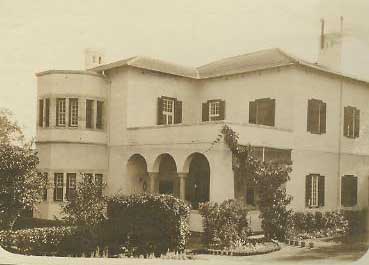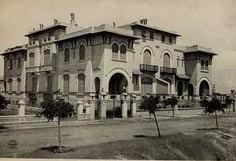


Early Gezirah villa: Bieglieben, Rowlatt, Privat
|
|
|
|
|
Cheers to our "talented" literature prize awardee. Your pain his gain !!!
|
|
|
EGY.COM - ZAMALEK
|
|
G
ezirah:
P
opulation
400
by Samir Raafat
Cairo Times, 24
May 2001



Early Gezirah villa: Bieglieben, Rowlatt, Privat
We are often reminded how, following the September 1869 opening ceremonies of the Suez Canal in 1869, emperors and princes were the first foreigners to sojourn on the island of Gezirah. To set the record straight I would like to add that the Gezirah Palace which served as temporary residence for visiting royals, was not built in record time in order to host Empress Eugenie during her much-ballyhooed tour. Preceding her at Gezirah by several months were the prince and princess of Wales.
But if all of the above were transient residents, who then, were Gezira's first long-term inhabitants?
While no established statistics deal directly with the subject, we can nevertheless determine some known facts by consulting one of several reference books published at the beginning of the 20th century. I chose the 1913 Egyptian Commercial Directory being one of the most comprehensive in its field.
Right, so what data did I come up with?
Going through the names of all of Cairo's listed residents, I discovered there were 83 medium to long term residents on Gezirah Island. Given a 5% margin of error and assuming most of the above had families plus one or more living-in hired help, we can deduce that the island's population in 1913 was about four hundred.
The islands was most definitely a British settlement. The directory spells out 53 British names most of them senior civil servants in the Egyptian administration including the governor of the National Bank of Egypt and the Sirdar, who besides being the governor of Sudan was also the British commander of the Egyptian Army.
Next comes Belgium with six bona fide residents followed by five Germans. Sharing fourth place were three Swiss and three Jews. Then came two Austrians, a Greek tobacco magnate, a Dutch consul and a Swedish count. To be added to this list are five residents of unknown origins and three Egyptians.
In those days Gezirah island was a strictly bedroom community, hence there was no commercial street, no banks, no gas stations, no shops. Except for the German Dairy fronting what we know today as 26th of July Street then known as Avenue Boulak there were no bakeries or food outlets on the island. For fresh produce, milk and eggs there was a Sunday market on the northern part of the island where patches of vegetable and fruit gardens still existed
On the other hand, the island boasted several amenities and tourist facilities. One of these, the Gezirah Palace now turned into a luxury Hotel provided the island's residents with a post office, a telegraph and a public telephone. The local stables could be found on Avenue Zamalek (ow 26th of July).
The island's other claim to fame was the members-only Khedivial Sporting Club (renamed Sporting Club). There was also the nearby Anglo-American Hospital. And at the southern tip of the island there was the Thomas Cook mooring facilities from where travelers embarked for Upper Egypt. Opened to the public was the Fish Grotto or Aquarium that had just celebrated its 12th anniversary.
And there was Café Gezirah. The latter was located next to Kasr el Nil Bridge, its owners Messrs. Dalbagni & Corbetta apparently the only two Italians with a legitimate stake on the island.
One of the most common addresses was 'Gezirah Palace Gardens' leaving us with the assumption that most of the island's inhabitants lived near or around the Gezriah Palace Hotel, for a long time the island's nucleus.
In many instances, the Directory simply lists a name followed simply by Gezirah indicating that the whereabouts of the island's few residents so well known, there was no need for further detail. The only addresses with streets and a house number were located on what we know today as 26th of July Street then known as Avenue Zamalek.
And there are those villas that came with indicative names like Villa San Giorgio, Villa Beauregard, Villa Lyons, or the names of villas named after its owners like Villa Hermann, Villa Beanett, Villa (Gaston) Privat, Villa (Levy) Garboua, Villa Gordon, Villa Badaro. For the more nature-inclined we find villas al-Shagertein (two trees) and al-Ashgaar (the trees) as well as Yildiz (Turkish word for shooting star) Cottage. There is also a 'Hareem Building' listed, most probably an annex of the ex-Gezirah Palace.
The only two apartment buildings on the island was Gezira House (today, opposite the British School) and Grotto House (address unknown) which is why we find several names linked to these address. Likewise, whenever we find two names associated with one address we can safely conclude this concerns one of Zamalek's semi-detached villas such as the ones still around on Ahmed Heshmat Street.
We also find that there were two dahabiehs (houseboats) moored to the island. "Herodotus" occupied by the director of Thomas Cook and "Hathor" occupied by a Mr. G. W. Fraser who worked for the Ministry of Finance.
Whereas names of the island's non-British are listed in full, we find that almost all the British residents only give away their surname with one or two initials appended like it was no one's business to know more.
Of the three Egyptians listed we find two were pashas and the third a bey. Two were Moslems, one a Copt. All three had strong British connections and thus reservedly welcome on the British island-colony.
|
Reader Comments |
|
|
|
|
|
|